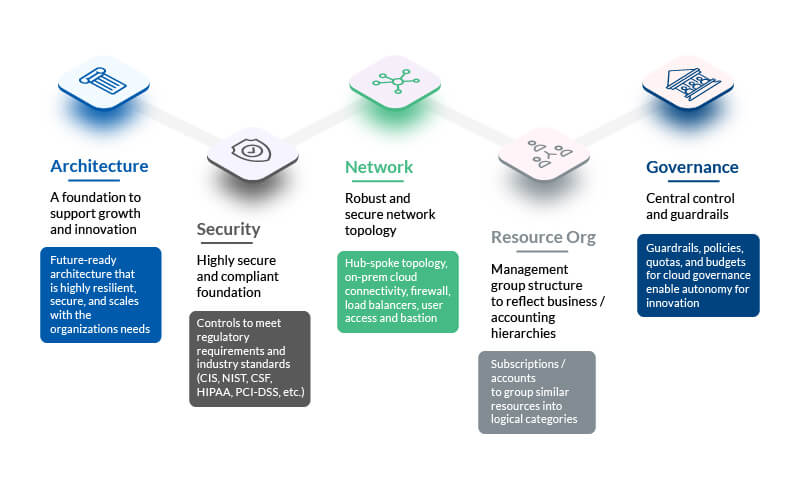Cloud computing provides many business benefits to organizations, whether large or small, such as agility, cost reduction, rapid innovation, faster time to value, and employee productivity. However, getting the cloud adoption right can be challenging if it is not planned well, leading to increased migration costs and degraded application performance. It is imperative to understand that cloud adoption brings many challenges, complexities, and risks that must be carefully managed to realize the many benefits of cloud migration.
This blog will review the fundamentals of Cloud Landing Zone, its components, implementation process, and benefits. But before we get there, let’s understand the high-level process of the cloud transformation journey. The cloud adoption journey comprises four stages:
1. Strategy
In this phase, businesses and IT leadership formulate the cloud adoption strategy, which defines business drivers, technical drivers, financial considerations, and business outcomes.
2. Assessment & Planning
This phase involves discovering and assessing the existing digital estate in data centers, infrastructure components, application and software stack, dependencies, and so on to identify cloud readiness status, blockers, existing TCO, and Cloud TCO. The outcome includes the R-treatment, cloud transformation business case, and migration roadmap.
3. Build Cloud Foundation
In this phase, the architect team will design and build a cloud Landing Zone, the foundation and target architecture for migrating and deploying IT workloads on the cloud.
4. Migration
This is an execution phase wherein workloads on the premises are migrated to the target cloud platform in various waves per the defined plan and set procedures. Usually, this is the longest stage of the cloud transformation journey and can span many months. The success of migration predominantly depends on how efficiently the earlier stages are planned and executed.
CloudOps
Once the workloads are migrated to the cloud, monitoring and managing them for availability, security, resiliency, performance, and ongoing cost is imperative. CloudOps ensures that the right processes, tools, and frameworks are in place to support business operations on the ground.
Establishing a well-thought foundation and Landing Zone is the beginning of your business journey to the Cloud. However, it is essential to understand what a cloud landing zone is, its benefits, and how it works.
What is a Cloud Landing Zone?
Landing zones provide an effective way to simplify and de-risk cloud adoption by providing a pre-configured foundation to build on in the vast ecosystem of the cloud. A landing zone comprises building blocks to build a well-architected cloud foundation. These building blocks include network connectivity, governance, security, identity management, business continuity, logging, and monitoring.
Landing zones should align with the broader organizational strategy and industry regulations, enforcing best practices for any workload deployed to the cloud.
Here are the various stages of building an adequate cloud foundation:
Assessment
This stage involves collaborative and guided discovery workshops to assess the current state, understand business objectives, and identify key drivers and requirements for the target state.
Cloud architects study existing IT landscapes, organizational structures, network layouts, security frameworks, guardrails, high availability, disaster recovery, and compliance requirements.
Design
This stage aims to create a landing zone blueprint aligned with Cloud Well-Architected Framework and organizational standards.
Here are the critical design areas for an enterprise-grade landing zone:
- Enterprise Enrollment
- Resource Organization
- Security & Compliance
- Identity and Access Management (IAM)
- Network Topology and Connectivity
- Governance and Guardrails
- Logging & Monitoring
- Cost Management
- Business Continuity and Disaster Recovery

Each building block of the Landing Zone represents its attributes and purpose in building the cloud foundation. For example, in Governance, we need to establish guardrails, budgets and usage quotas, naming conventions, standardize tagging, build policies (that will force or block some behaviors), and so on.
In networking, we must figure out how to create hybrid connectivity, allocate IP addresses, manage DNS, create PaaS solutions networking, create network architecture, plan secure internet communication, etc.
In identity, we must plan for account and subscription management, create roles, and manage hybrid identity if we have on-prem identity providers, create privileged identity management mechanisms (or use cloud-based existing ones), and manage service accounts for resources and applications.
The outcome of this stage is high-level and low-level Landing Zone design documents and customer sign-off of the design.
Build
In this phase, the design is converted into deployable code using Infrastructure-as-a-code (IaC) for automated and repeatable deployments.
- Implementing organization structure on cloud-like management groups, accounts, or subscription layout.
- Implementing hub landing zone having shared services components like hybrid connectivity, central firewall, load balancers, WAF, DNS, active directory, etc.
- Building governance controls like guardrails, policies, quotas, and role-based access controls (RBAC).
- Implementing spoke (application) landing zones based on the cloud migration roadmap.
- Establishing secure and private connectivity between on-prem and cloud to enable migration.
- Establishing procedures for key and certificate management.
- Establishing a process and framework for monitoring, alerting, and remediating cloud workload security.
- Setting up cloud cost monitoring, tracking, and reporting processes for the chargeback or show back.
Testing and Validation
This phase is critical to ensure that the cloud foundation is built per the specifications of the design documents. The following tests are performed:
- Functional Testing
- Non-functional Testing
- UAT Signoff
The Benefits of Having a Cloud Landing Zone
A well-architected cloud landing zone has many advantages to embarking on the journey to the cloud. First, landing zones enforce more robust enterprise compliance, security culture, and discipline in the organization. It allows architects to set up the right guardrails around specific user accounts, resources, business units, datasets, and various cloud components.
Landing zones also accelerate migrations and workload deployments to the cloud with ready foundations and structures. They eliminate manual and ad hoc configurations, enabling organizations to bring new products to market faster and at scale.
Similarly, landing zones help standardize network architecture, connectivity and configurations, hybrid connectivity, firewalls, load balancers, and so on for repeatable and rapid deployments at scale.
A landing zone is critical in establishing organizational guardrails on the cloud to control access, cloud resource usage, and cost through policies, roll-based access, quotas, and budgets.
Summary
The cloud landing zone offers a well-defined foundation and operating model that enables organizations to improve service quality and speed. If you want to speed up your migration to the cloud or consider the cloud for the first time for your business, a landing zone can provide you with the right foundation for the cloud adoption journey.
How Hexaware Can Help
Over the years, we’ve implemented many Cloud Landing Zones for various large and SME clients across the globe. As part of our cloud strategy, we build robust and purpose-built cloud foundations that align with customers’ business priorities, technical requirements, security, and compliance requirements. We believe in understanding businesses deeply to deliver enterprise-quality, scalable, and easy-to-operate cloud foundations. Our cloud foundation framework is built on a core set of artifacts refined over many customer engagements aligned to major Hyperscalers.
Our Amaze® platform, a US Patented IP, plays a significant role in helping enterprises mitigate their cloud migration risks and challenges, thereby providing a robust, industry-best solution.
For more information on our services and capabilities, please visit https://hexaware.com.



















